Review GSM phone Samsung X810
Package:
- Handset
- Battery
- Hand strap
- Charger
- Stereo headset
- Manual
Samsung X810. Live pictures
The company of Samsung often holds experiments with phone form-factor trying to correspond with fashionable tendencies. Such experimental models are seldom to reach the commercial launch, but nevertheless sometimes that happens. The X810 is a good example. That is a narrow slider with a navi wheel in an iPOD style. The model was created referencing this popular player, and even one of its colour schemes (milky white lacquered plastic) proves this. The second colour traditional for Samsung is black plastic with silvery sides and the back.

An attempt to create an outstanding slider resulted in the phone's width a bit less than its thickness (89x37x24 mm, 85 grams). The handset lies well in a hand despite some similarity with a bar, but it has no place for a normal keypad.

The number keys are dense, and the top row joins the slider cover very close making additional difficulties. The keypad ergonomics is worse than average, however even worse cases happen. The white backlighting is well seen in various conditions.

The navi wheel turns around. And moving around you move horizontally, for instance, in the menu. There is a point corresponding with the pressure direction. For instance, moving vertically in a horizontal list is possible both by rolling the wheel and choosing a horizontal line and pressing the wheel. And correspondingly selecting an item is possible by right wheel rotation and pressure. Unlike usual navi buttons you'll have to make an excess motion, sometimes which irritates. So, the wheel is not an improvement but more a step for increasing the image of the device, unfortunately, worsening its ergonomics. Nevertheless, the device is still workable, and you'll get used to this way of control, though it takes more attention and time.


The position of a megapixel camera module is also a peculiar feature (the module is completely alike the one of the E720). The module is placed in a rotational part with a loudspeaker; it is protected from dust when the device is closed. The unusual thing is the camera is combined with a loudspeaker working during the call (call melodies are reproduced by other loudspeakers). That's why you'll need to turn the camera module from yourself at an incoming call (if it was positioned differently) or you just won't be able to speak. Considering the fact we mainly take photos of the world and people around, then the camera position will be from your face by-default.

The screen's physical size of 24x31 mm (1.55") is caused by the phone dimensions. The screen resolution is 128x160 pixels which's untypical of today Samsung models. The screen hold up to 6 text lines and two service ones. It is TFT, fades in the sun little and the picture remains seen. The font-size is quite readable with no worsening as compared with the models of higher resolution.
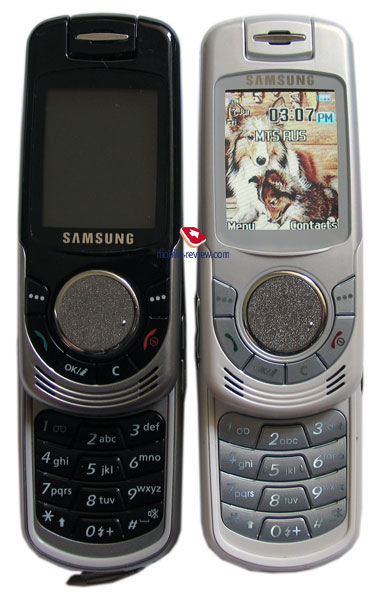

The slider allows all the actions in a closed mode traditionally for Samsung. There is an auto finishing mechanism working not very good due to the small body size, though makes moving easier (the motion amplitude is not enough).
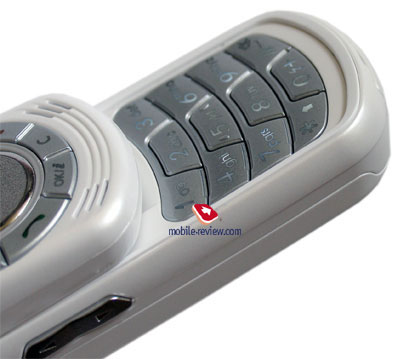
Two loudspeakers are placed under the screen and functional keys, they provide stereo sound. Unlike the D600 and Z300 the loudspeakers are distanced little (the phone is narrow), no stereoeffect, even theoretically. So, the consequence is the two loudspeakers provide loud sound and not more.

A volume button is placed on the left side, a camera button is to the right, and an mp3 one is a bit lower. A headset connector covered with a shutter is also here (miniUSB). The shutter is deeply sunk into the body, thus opening is hard sometimes. A strap hole is on the top of the device.

The battery having no backlash is the back of the phone. The capacity of this Li-Ion battery is 800 mAh. According to the manufacturer the battery is capable of 200 hours in the standby mode and up to 5.5 hours in the talk mode. In Moscow networks the phone worked averagely for 2-2.5 days with an hour of talks and up to 30 minutes of using other functions. Recharging will take you about 1.5 hours.

A standard SIM-card connector is under the screen. And a TransFlash memory slot is also here. Changing cards is possible only with the phone off, which is a disadvantage for those who'd like to use the phone as an mp3 player.
Menu
Like in the D600 you can choose traditional menu or small flash headbands. Number navigation is supported. All the submenus are lists. Besides memory cards, you can use the present 90 MB of dynamical memory. In all the rest the model is a copy of the present solutions with no peculiarities.
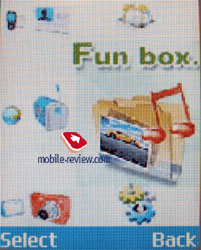 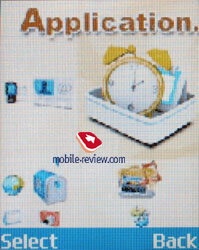
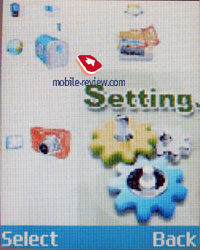 
Phonebook. By pressing the right soft key, one can obtain the contacts in a form of a list containing all the files both from the phone's and the SIM-card memory. The first name in the list is backlit by default and the number is shown in the status bar (there is a special sign for numbers from a SIM-card). There is a fast search by first letters of a name; the phone can hold more than twenty of those for any possible language. By pressing the OK key, you enter in the view menu of a single file where you may see a small icon in case the name is matched with the image. Any graphic file or the pictures of your own may be used as such image. Up to five phone numbers of various types (cell, office, home, fax, etc.) may be kept for a name with one number as the main contact (it would become the first one by default). The fields are strictly fixed and there may be not two cell phone numbers entered. On the other hand, SMS/MMS can be sent to any number from the phone book once chosen.
 
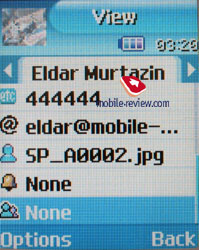 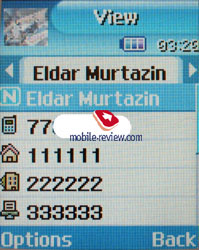
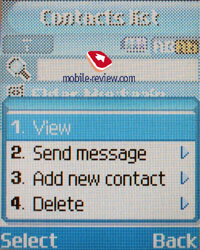 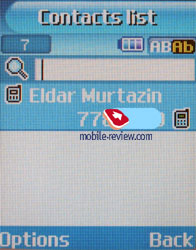
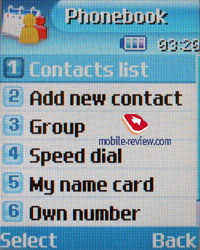
There are two fields for a Name and a Surname (search only by the first one) that are concatenated when displayed and the Name field goes the first. For example, if you entered Eldar Murtazin, it is displayed exactly in this manner. The length of each line is 20 symbols for any of the available languages. You may opt to alter the language while inserting the text as well.
Files in different languages are sorted out according to a rule - first it will be all files in the local language (Russian, for example), and then those in English. This is rather convenient and habit forming. Taking into account an option of fast language change during the search, it becomes clear that the files in different languages do not impede the work with this phone.
Let us return to the information entered for one name. Besides phone numbers, an e-mail address and a little text memo can be recorded. Any music file as well as composed MP3's can be chosen as a ring tone for the name. Three caller groups are preinstalled and out of any category. You can easily create a necessary number of groups, select a personal melody and image for each.
Up to 1000 names with all the data can be saved in the phone's memory. Even if all the available lines are not used, the number of names to be saved would remain a thousand. It is possible to indicate in the settings where the new numbers should be kept by default. There is an option of moving files from the SIM-card although not vice versa. According to the developers, PC is the best means of synchronization, MS Outlook in particular. Any file in the form of SMS/MMS, mail message or other text file can be sent quickly through Bluetooth to another device. There are no problems with sending and the phone book entry being transmitted to another device is precisely decoded without any trouble.
New names can be entered only through the main menu; the right soft key always calls for the name list only. You can create your own visit card; its format would be the one of a regular file from the phone book.
There can be up to eight numbers in the speed dial list; peculiar is the fact that separate numbers of one name may be in this list as well. The subtitle of the chosen name (but not of the phone type) is displayed on the buttons.
The comparison of this phone book with phone books of other phones is rather interesting. It is not fully compatible with MS Outlook's layout as the phone has fewer fields. Consequently, the phone gives way to all the smartphones (the phone book options are the most extended ones in those). The phone book is moderate here when compared to the phones such as Siemens and Alcatel. However, the model is a decent rival to all other phones. The phone also has a very convenient phone book, which is a pleasure to work with.
When receiving a call, a picture is not displayed on the full screen, but only on a part of it (approximately 96x96 pixels).

Call lists. Up to twenty phone numbers are displayed in each list. There is a combined list of all the last calls with an icon indicating a call type. Tilting the scroll key horizontally, you may switch quickly from one list to another. The date and the time of the call (it's duration is not kept) can be seen for separate files. As always, the overall time of the calls and their prices can be viewed in this menu (this service has to be installed).
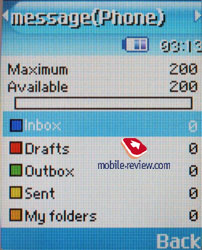

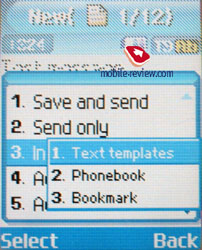 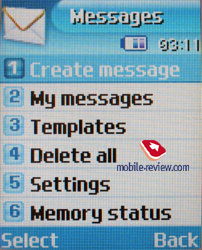
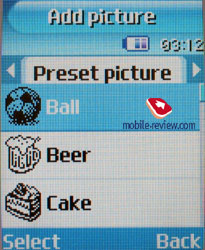 
Messages. Working with various types of messages is done through separate submenus. Let us begin with short messages. Up to 200 messages can be saved in the phone's memory; the phone supports the EMS standard compatible with Nokia Smart Messaging. The support of various encodings chosen by a user (GSM or Unicode) is a very nice feature here. T9 functions very well and is quick and easy to use.
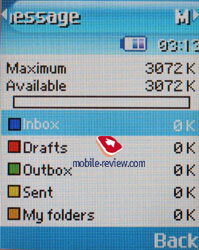 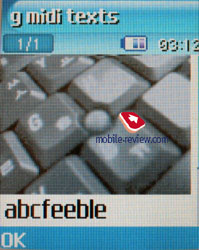
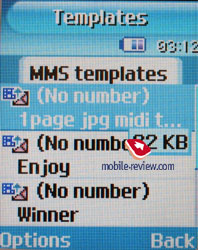 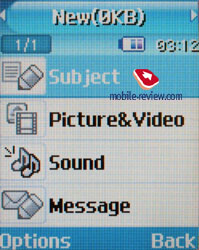

MMS. The interface for multimedia messages is very nice; the messages can be saved in several folders at once and right away. There are no size restrictions for a message to be received although an outgoing message should not exceed 295 KB. As for additional services, the rejection of advertising messages, the option of the message receipt in the roaming and the home network should be mentioned. The messages are saved in the general memory since there is no special memory for them.
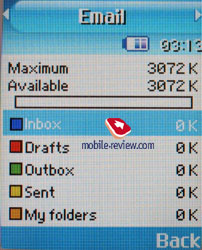

Mail client. POP3/SMTP boxes and several tracking files are supported. Besides the title downloading, the phone can receive the letter itself. As for attachments, only the graphic files (GIF, JPEG) are supported. When sending a letter, you can attach a picture from the integrated camera to it. Overall, the mail client is nice although it does not stand out with an immense number of functions. There is also an option of creating templates.
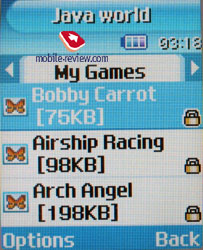 
Applications. Java World is the first menu item; up to four MB of memory are available in the phone for various programs. This is a separate memory allotment and is used for Java only. MIDP 2.0 version allows the use of the graphic reach and three-dimensional games. There are four games preinstalled in the phone - Bobby Carrot, Airship Racing, Freekick and Archangel.
 

MP3 player. An integrated mp3 player supporting random track reproduction, sequential and cyclic, is available in the phone. Mp3 files can be downloaded into the phone both directly through Bluetooth and through a synchronization program. Files may be of various names and tags (in Russian language as well!). The bit rate of the files is not that important since the phone accepts all the possible formats. We came across several problems with the files recorded through VBR since the phone would report an error and reject downloading. However, a number of the same VBR mp3 files were successfully downloaded and reproduced without any problem.
The title of the track playing is displayed as well as the overall number of different composition. An equalizer is of an entertaining nature; there are no separate settings (only a possibility to choose from classic, rock, jazz and normal reproduction). The tracks can be played through the stereo headset as well as through the speakerphone. The volume has ten levels. The user is welcome to create play lists of his/her own. There is 90 MB of memory available for mp3 compositions, which is enough for recording more than an hour and a half of qualitative music. The player is realized neither better nor worse than ones by other manufacturers. Everything is quite plain.

Image editor. A plain picture editor that allows transforming files almost completely and using various tools.

Dictaphone. You can record up to several hours of voice memos with the number of files being unlimited. The time restrictions for one recording are set by a user and can vary from 30 seconds to one hour in duration. All the files are kept in a separate folder in the memory. The dictaphone cannot record a conversation, since it only works in stand-by mode. Two types of equalizers are offered in the settings with one of them meant for noisy surroundings. The recorder can function well during lectures, conferences and presentations. The phone is a partial substitute for a digital tape recorder.
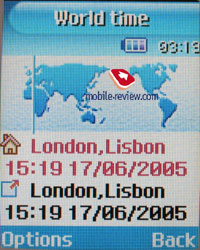
World time is displayed for two chosen cities. Everything is nice and simple here.
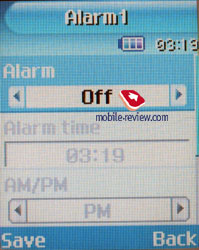 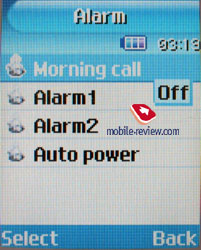
Alarm clock. The phone is equipped with three alarm clocks. One is meant for mornings and can be set for selected weekdays as well as for weekends. For each of the alarm clocks there is a selection of five melodies although mp3 compositions cannot be used here. It is up to a user to indicate in the settings whether the phone would turn on automatically in the time of the event or not.
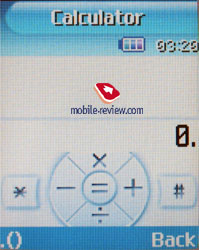
Calculator. Everything is nice and simple here.
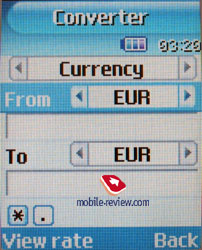
With a converter, you can operate with different units of measurements as well as with the currencies.
 
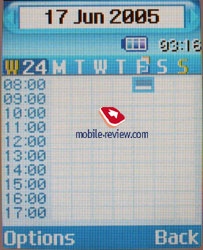 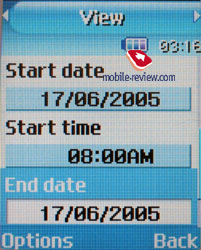
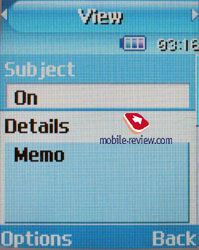 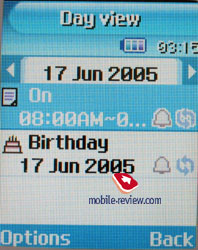
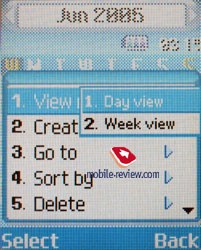 
Calendar. Up to 400 events of four types - meeting, affair, anniversary and others, can be saved in the phone's memory. The day and the time as well as its end are indicated for each file. A signal can be set for the interval during which it has to go off; repetitive events are available for setting.
The weekly and the monthly calendar are very convenient with each type of the event having its own color.
Also a user can create up to 50 text memos up to 100 characters in length each. No alerts or signals are preserved for these memos.
WAP. There is a wap-browser version 2.0 similar to some phones by Nokia and Sony Ericsson using http protocol. That means in some networks operator's setting is required.
 
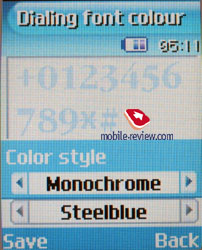 
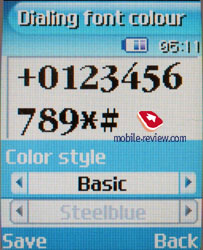 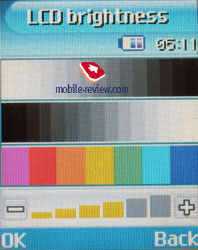
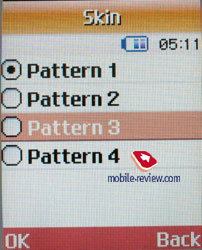 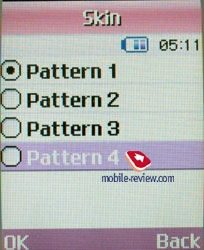
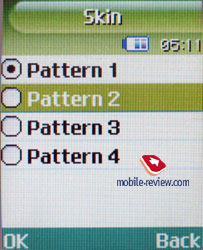 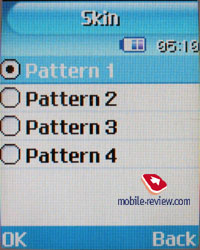
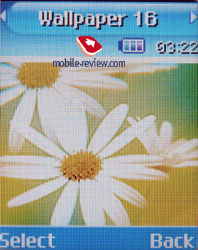 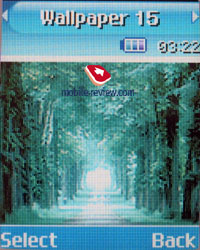
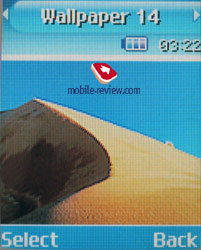 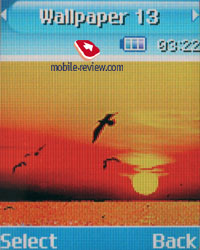
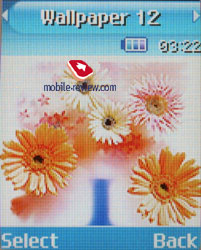 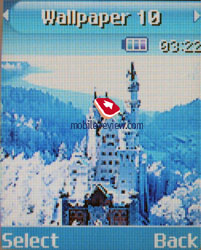
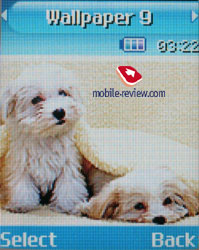 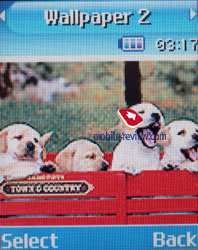
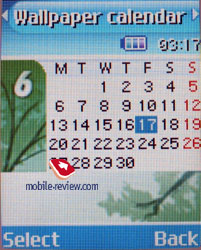 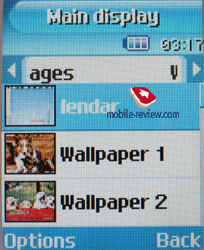
 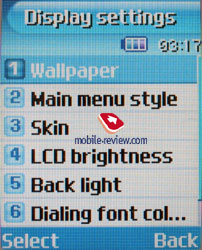
Settings. That is traditional that you are allowed to choose font colour in the standby mode, protect any section of the phone with a password (messages, short messages, organizer and so on). You may set the time for backlighting on and its brightness.
Themes are absent in the phone that is different to Sony Ericsson and they are replaced by Skins. There are two of them and two of them allow changing not only a colour scheme but a header also, it gets roundish. In some kind that is the first prototype or if you want the first step to a possibility to change the interface completely, let's see what will the future models bring.
 File Manager. Here are all the files such as music, pictures, video and sounds. All the uploaded files get here. The disadvantage is files sometimes are not displayed in the list immediately, you need to leave the menu and enter it again.
Synchronization with PC. Synchronization is made using Bluetooth and a cable. Easy Studio 2.0 will be included into a delivery kit (or provided on the manufacturer's site) that is a renewed version. There are many changes comparing to the first version and we won't tell about all of them. I'll only note that this software is similar to programs for synchronization by other manufacturers in some kind (in a maximal configuration) but also provides its own capabilities.
Impressions
The connection quality is high and rouses no complaints. The volume of the 64-tones polyphonic alert is enough to hear from your bag. Women are the main audience of the model and the phone is targeted at them. Small size and colour solutions tell about that. The device looks not in its place in man's hands.
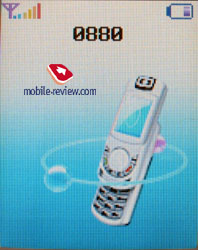 
The phone is interesting as an experiment in design. However its ergonomics is not quite right for everyday use. The realization of a navi wheel and a small keypad are its minuses. The screen is comfortable despite its size, and information is well read. The device may be considered an assortment model, since functionally it resembles Samsung E720 with a memory card correction. We think not so many people would like to buy this model for 400 USD, however, it depends on advertising. In the presence of already issued Samsung products with similar functionality and some rival products with no designer idea, you should choose them. Even considering the advertising the X810 may get popular for little. The interest to the model won't be durable.
Eldar Murtazin (eldar@mobile-review.com)
Translated by Maria Mitina (maria.mitina@mobile-review.com)
Published — 12 July 2005
Have something to add?! Write us... eldar@mobile-review.com
|















































































